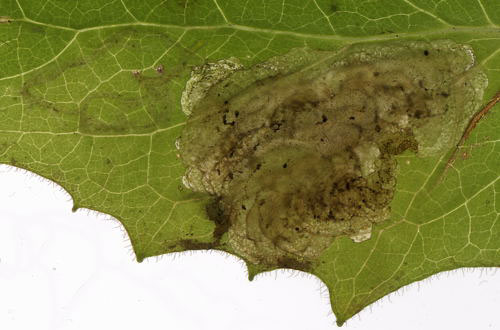|
||||||
|
MYCELIS. Wall Lettuce. [Asteraceae] |
|
Wall Lettuce (M. muralis) is the only species of Mycelis recorded in Britain. It is a native species. Eleven or twelve British miner is recorded on Mycelis. A key to the European miners recorded on Mycelis is provided in Bladmineerders van Europa. |
Key for the identification of the known mines of British |
Note: Diptera larvae may live in a corridor mine, a corridor-blotch mine, or a blotch mine, but never in a case, a rolled or folded leaf, a tentiform mine or sandwiched between two more or less circular leaf sections in later instars. Pupation never in a cocoon. All mining Diptera larvae are leg-less maggots without a head capsule (see examples). They never have thoracic or abdominal legs. They do not have chewing mouthparts, although they do have a characteristic cephalo-pharyngeal skeleton (see examples), usually visible internally through the body wall. The larvae lie on their sides within the mine and use their pick-like mouthparts to feed on plant tissue. In some corridor miners frass may lie in two rows on alternate sides of the mine. In order to vacate the mine the fully grown larva cuts an exit slit, which is usually semi-circular (see Liriomyza huidobrensis video). The pupa is formed within the hardened last larval skin or puparium and as a result sheaths enclosing head appendages, wings and legs are not visible externally (see examples). See Key to non-Diptera. |
1a > Stem miner: An external stem mine with frass in two rows of disconnected strips. Pupation in stem at end of mine (Spencer, 1972b: 25; Spencer, 1976: 61 (fig. 63B), 65-6). |
|
Ophiomyia heringi Stary, 1930 [Diptera: Agromyzidae]. |
1b > Leaf-miner: Mine primarily associated with mid-rib. |
1c > Leaf-miner: Mine not primarily associated with mid-rib. |
2a > Leaf-miner: A distinctive mine primarily above mid-rib, with irregular short lateral offshoots into leaf blade. Pupation external (Spencer, 1972: 51 (fig. 172), 55; Spencer, 1976: 270, 271 (fig. 486)). Branched, whitish, upper-surface corridor; main axis overlying the midrib; side branches overlying the main lateral veins. (In Campanula and Phyteuma the mine is much less branched, sometimes nothing more than a corridor on top of the midrib). Frass in rather long strings. Usually the mines begins as a long and narrow, shallow, tortuous lower-surface corridor that ends upon the midrib but otherwise is not associated with the leaf venation. Often this initial corridor is filled with callus, and then even less conspicuous. Pupation outside the mine. A linear mine on the upper surface, usually following the midrib and showing side branches along the veins. The frass is in strings. |
|
Liriomyza strigata (Meigen, 1830) [Diptera: Agromyzidae]. |
2b > Leaf-miner: A whitish blotch mine along mid-rib, with offshoots into leaf blade. Pupation takes place at the base of the mid-rib (Spencer, 1972b: 25; Spencer. 1976: 63 (fig. 66)). The mine begins as a very narrow, upper- or lower-surface corridor, somewhere in the blade. When this hits a thick vein the larva uses this to descend towards the midrib. From that moment the lave lives in the hollow midrib. From here short, lobate corridors enter the leaf blade. The larva may move to another leaf by way of the leaf base. The corridors in the leaf are virtually free of frass (at most a few grains where they leave the midrib); frass is concentrated in the base of the midrib. Here also the pupation takes place. |
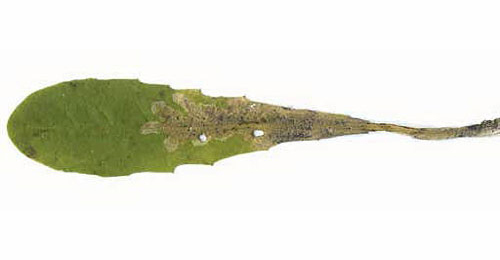 Mine of Ophiomyia cunctata on Taraxacum officinale Image: © Willem Ellis (Bladmineerders van Europa) |
|
Ophiomyia cunctata (Hendel, 1920) [Diptera: Agromyzidae]. |
3a > Leaf-miner: Mine linear, whitish, both upper and lower surface. Pupation internal, at the end of the mine with the anterior spiracles projecting through the epidermis (Spencer, 1976: 433). Upper-surface, less often lower-surface corridor. Frass in isolated grains. Pupation within the mine, usually in a lower-surface puparial chamber. A long whitish upper surface corridor, which eventually goes lower surface. |
|
Chromatomyia
horticola (Goureau, 1851) [Diptera: Agromyzidae] |
| 3b > Leaf-miner: Larva
mining both lower and upper surface, unusually long, linear, conspicuously
broad, frequently largely on the underside of the leaf. Pupation
external (Spencer, 1972b:
76 (fig. 251); Spencer, 1976:
445 (fig. 780), 446).
Corridor mine. The first part consists of a very long and narrow lower-surface corridor; the mine is quite shollow here, and often inconspicuous. The second part is upper-surface, uusally much shorter, and widens abruptly. Pupation outside the mine. |
|
Phytomyza marginella Fallén, 1823 [Diptera: Agromyzidae]. |
3c > Leaf-miner: A small primary blotch, often several larvae feeding together (Spencer, 1972b: 56 (fig. 186); Spencer, 1976: 270, 271 (fig. 483)). Brown, upper-surfsce blotch; often several larvae in a mine. The blotch is preceded by a short initial corridor, often overrun by the later blotch. Frass in a few, small grains. Secondary feeding lines well visible. Pupation outside the mine, exit slit in upper epidermis. Small upper surface blotch, with occasional galleries leading from the blotch. Often several larvae feeding together. |
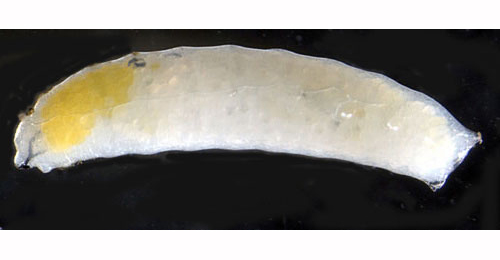 Liriomyza sonchi larva, lateral Image: © Willem Ellis (Bladmineerders van Europa) |
|
Liriomyza sonchi Hendel, 1931 [Diptera: Agromyzidae]. |
3d > Leaf-miner: A white mine along mid-rib, with offshoots into leaf blade. Pupation internal at base of mid-rib. In Asteraceae the larva mostly lives as a borer in the midrib of the leaves. From there short corridors are made into the blade. Also a corridor can be made overlying the midrib. In Euphorbia a small mine is made in the bracts of the inflorescence. The final mine strongly resembles the one of Liriomyza strigata, but the branches are vritually free from frass; this is acccumulated in the resting place of the larva, in the base of the midrib. There also pupation takes place. Forms a mine along the midrib and has feeding spurs into the leaf. Pupation is in the mine at the base of the midrib. |
|
Ophiomyia beckeri (Hendel, 1923) [Diptera: Agromyzidae]. |
3e > Leaf-miner: The mine begins with a very narrow full depth corridor, that ends upon the midrib. Subsequently a broad corridor, or rather an elongated blotch, is made overlying the midrib; from here broad, lobe-like extensions are made into the blade. Frass in discrete grains. Secondary feeding lines conspicuous. The larva is capable of leaving the mine and restarting in a new leaf, in which case the association with the midrib may be lost. Pupation after vacation of the mine. |
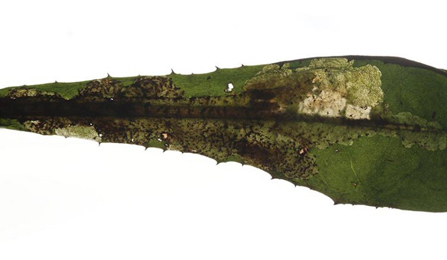 Mine of Trypeta immaculata on Taraxacum Image: Rob Edmunds (British leafminers) |
|
Trypeta immaculata (Macquart, 1835) [Diptera: Tephritidae]. |
3f > Leaf-miner: The mine begins as a long, quite narrow corridor, usually not far from the tip of a leaf segment. Usually this corridor follows the leaf margin for some distance, but it may also run freely through the blade and may then be stongly contorted. In the end the corridor is directed towards the midrib, where an elongated blotch is formed, overlying the midrib and some of the larger lateral veins. Frass in a nearly continuous line in the initial corridor, in scattered lumps in the later part of the mine. Primary and secondary feeding lines very conspicuous when seen in transparancy. Pupation outside the mine. The mine starts as a very narrow corridor, usually close to the tip of a leaf segment and following the leaf margin. The later section of the corridor approaches the main vein, where an elongated blotch is made with long broad finger like extensions that lay over the secondary veins. In the initial corridor the frass forms an almost continuous line, in the blotch it is distributed in large scattered lumps. In fresh mines the secondary feeding lines are clearly visible. |
|
Trypeta zoe Meigen, 1826 [Diptera: Tephritidae]. |
3g > Leaf-miner: Elongated upper-surface blotch, preceded by a corridor (exceptionally, visible in the picture, as a long lower-surface corridor). Primary and secondary feeding lines conspicuous. Older mines quickly turn brown. Pupation outside the mine. The mine starts as a corridor which quickly broadens into a blotch, which appears dark with white borders. It is intitially circular or slightly elongated but becomes irregular as the mine matures. The larva is shown and feeding lines are also visible. The mine quickly turns brown and pupation is ouside the mine. The adult was bred and emerged on 10.vii.2017. First discovered in the UK in 2010 (Godfray, 2011). |
|
|
| Liriomyza puella (Meigen, 1830) [Diptera: Agromyzidae] |
|
Key for the identification of the known mines of British |
Note: The larvae of mining Coleoptera, Hymenoptera and Lepidoptera may live in a corridor mine, a corridor-blotch mine, a blotch mine, a case, a rolled or folded leaf, a tentiform mine or sandwiched between two more or less circular leaf sections in later instars. Larva may pupate in a silk cocoon. The larva may have six legs (although they may be reduced or absent), a head capsule and chewing mouthparts with opposable mandibles (see video of a gracillarid larva feeding). Larvae of Hymenoptera and Lepidoptera usually also have abdominal legs (see examples). Frass, if present, never in two rows. Unless feeding externally from within a case the larva usually vacates the mine by chewing an exit hole. Pupa with visible head appendages, wings and legs which lie in sheaths (see examples). |
1a > Leaf-miner: The eggs of this species are laid on a leaf, with the larvae mining the underside of the leaf, until a late instar when it feeds in a web under the midrib of the leaf, causing visible blotching on the upperside. Short, full depth corridor. The larva relatively long lives as a miner, but finally leaves the mine and continues living in spinning along the midrib at the leaf underside, from where windows are eaten in the leaf. |
 Mines of Agonopterix propinquella on Cirsium arvense Image: © Ian Smith (UKMoths) |
|
Agonopterix propinquella (Treitschke, 1835) [Lepidoptera: Depressariidae] |
1b > Leaf-miner: The mine begins in the midrib, especially in a lower leaf, extending into the leaf disc, branching irregularly or pinnately, may also locally be blotch like. The mine is brown and very transparent. Sides very irregularly eaten out. Frass loosely dispersed or in a loose central line, buy may also be pressed against the sides of the corridor. The larva may also leave the mine and restart elsewhere. |
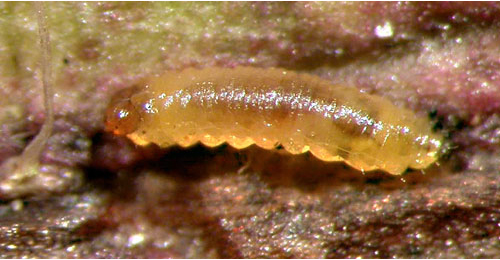 Orthochaetes setiger larva, dorsal Image: © Jean-Yves Baugnée (Bladmineerders van Europa) |
|
Orthochaetes setiger (Beck 1817) [Coleoptera: Curculionidae]. |
| Last updated 06-Jul-2019 Brian Pitkin | ||

